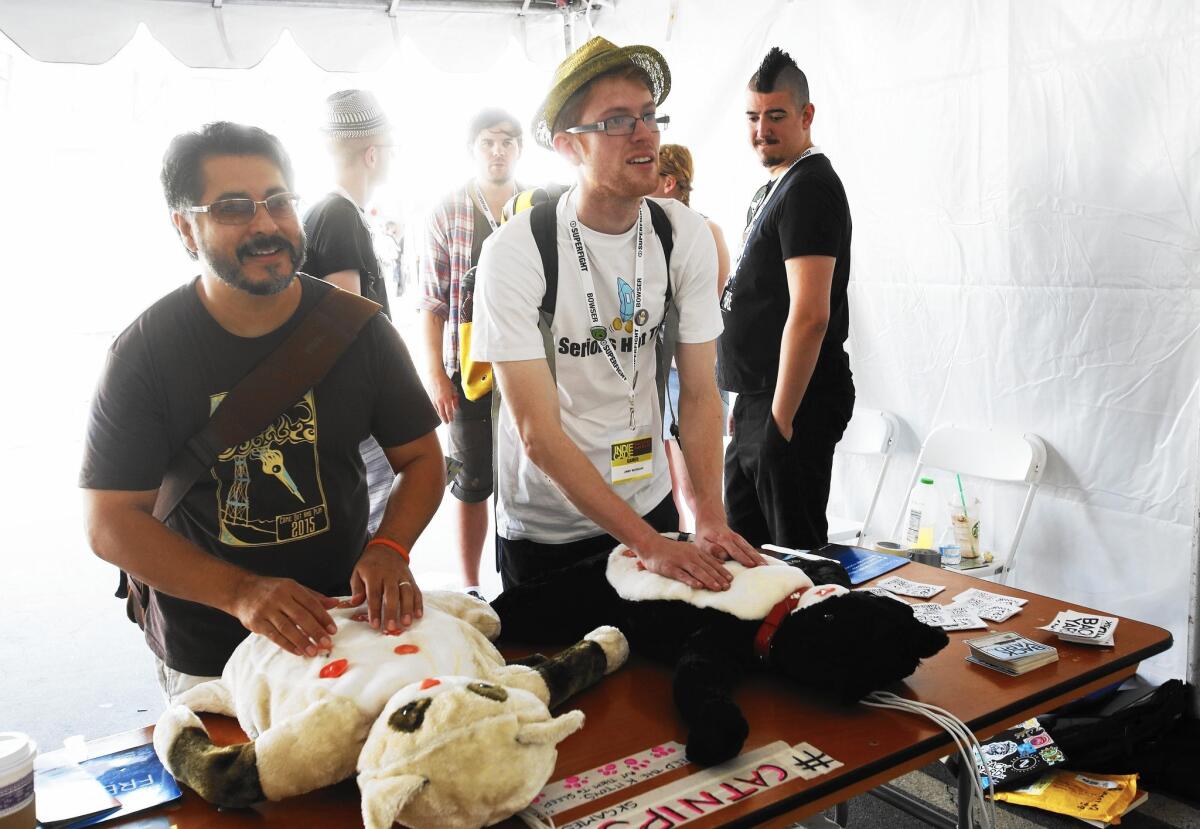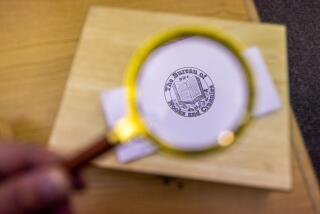The Player: IndieCade festival helps game enthusiasts savor the ‘subtle stuff’

- Share via
I was sitting cross-legged inside a tent that was inside an old Culver City firehouse. In front of me was a plush rock with a smiley face on it, only I couldn’t see the happy rock because I was wearing a virtual reality headset. I was playing a game titled “The Meadow.”
In the VR headset I could see a calm forest, one in which the rocks appeared happy to see me. Simply looking at the virtual rocks caused them to roll toward me.
In the real world outside the VR headset, my in-game gazes inspired the project’s creator to roll the stuffed rock at my feet. “The Meadow” is designed to be immersive, so much so that those who worked on the game attempt to respond to the player’s every reaction.
SIGN UP for the free Essential Arts & Culture newsletter >>
“The Meadow” was meditative, playful and surreal. Then night fell, and red-hued, one-eyed creatures began leering at me. Was I scared of them? Were they scared of me? Who even was I, the player, in “The Meadow”? And could I stay here long enough to find out?
No, the experience ended in 10 minutes, but not before it challenged the very idea of what it means to play a video game.
“The Meadow” was one of more than 200 games showcased at IndieCade, a weekend festival that concluded Sunday evening in downtown Culver City. IndieCade is dedicated to those working outside the mainstream game industry, many of whom are advocating for new ways to play.
“I’m interested in focusing on the ways in which a player is active other than the big empowering verbs that video games normally have,” said “The Meadow” creator and USC Games professor Richard Lemarchand. “When you remove those big empowering verbs from game design, then there’s room for lots of really subtle stuff to come through.”
Subtle stuff is what many of the more than 7,000 estimated attendees at IndieCade experienced throughout the weekend. IndieCade reached capacity on Saturday afternoon, and lines on Friday to play some games stretched five or six people deep.
The fest’s growth, coupled with increasing development in Culver City, means that IndieCade may be searching for another locale next year, although organizers said Sunday they were optimistic the event would continue to call Culver City home. What those who attended over the weekend saw was a mesh of board games, virtual reality games, video games and even playground games, many of them attempting to put the player in previously unexplored territory.
There were games such as “Cibele,” which put the player in the anxious role of meeting a crush for the first time. It did so not by asking us to mash buttons on a controller, but by simply encouraging us to explore someone’s innermost thoughts. There were games such as “Apartment: A Separated Place,” which put the player on a quest for emotional normalcy after a relationship breakup. Walking around a virtual room felt safe, if melancholic. The demons here were in your head.
Then there were games such as “Nevermind,” which on one level tried to scare us, and on another tried to teach us something about how we manage stress. It used biofeedback technology. Get scared, and the game got harder.
“It’s to help players become more mindful of what sensations they feel when they get stressed,” creator Erin Reynolds said. “Seeing that real-time feedback in the game when they’re starting to feel that tightness in their stomach or that tension in the shoulders, it helps call more awareness to what those feelings are like. We reward the player for calming down by making the game easier.”
More lighthearted: “Story Warriors: Fairy Tales,” a mobile game in which the act of reading became a game itself. Press an adjective or a verb, and maybe it sprang to life to solve a puzzle. “Kwaan,” a multiplayer game about companionship, asked if it’s possible to fall in love with a virtual world. I’m not sure myself, but I do want to revisit it.
Then there’s “Her Story,” the game that won top prize at IndieCade’s Thursday night award show. “Her Story” is in many ways a detective game. If you know how to use Google, creator Sam Barlow likes to say, you can play the game. In “Her Story,” you act like a detective — or maybe more like a librarian — as research is your only objective.
Two puzzles drive “Her Story.” One concerns a subject that was once interrogated by the police. You, the player, are trying to piece together old interview footage. The other puzzle concerns the player. Not until the final moment of “Her Story” does Barlow let us in on the player’s role, a marked shift from games where we’re giving a persona, a plot and a goal.
At its heart, IndieCade isn’t about competition or challenges. As the festival has grown over the last nine years, so has the independent game movement, giving the game industry at long last diverse experiences that attempt to capture the full human experience.
“Donut County” has players wiping out terrain to make a statement about gentrification. “Oxenfree,” on the other hand, lets us ponder the silly conversations among teenagers amid supernatural occurrences. And what to make of “Aboard the Lookinglass,” a virtual reality game in which players just have to wave hands to see the past or the future?
Throughout IndieCade, there were workshops and discussions geared toward developers, and there was even a little advocacy, as Intel sponsored a so-called games for everyone tent that was aimed at welcoming new voices.
But IndieCade itself is already an agent of change.
At a time when the game industry is entering blockbuster season — massive franchises such as “Assassin’s Creed,” “Halo,” “Call of Duty” and “Tomb Raider” are receiving updates this fall and winter — IndieCade managed to turn down the noise. It showed us that a breakup, a first kiss, a wave of a hand or simply the act of research can be a way to play.
“I’m always most excited about seeing games at IndieCade that just go places we haven’t gone before,” said Tim Schafer, a veteran of the industry who founded the Bay Area’s Double Fine Productions and previously worked for LucasArts.
“Life is very broad,” Schafer added. “Games look at a small part of it. So any time people try to look at a different part of it, it’s exciting.”
Follow @Toddmartens for more video game reviews and ruminations from The Player.
More to Read
The biggest entertainment stories
Get our big stories about Hollywood, film, television, music, arts, culture and more right in your inbox as soon as they publish.
You may occasionally receive promotional content from the Los Angeles Times.











